Top 5 Tube Saturation Plugins: An Audio Showdown of the Best Dedicated Tube Saturators
The word “tube” causes many of us to instantly think of good ol’ classic tube guitar amps, “giving the guitar some glow”. But vacuum tubes, which were once a necessary component of most audio circuits, can come as part of almost any piece of audio gear.
Like guitarists, audio engineers have long exploited the characteristics of tubes (or “valves”) through any number of classic EQs, compressors, mic preamps and effects boxes. Now that tubes are a 100% optional feature in audio circuits, using them effectively is all about finding the right time and place to bring a tube into the signal path.
One irony of making music today is that the more digital we have become, the more we seem to strive for ”analog warmth”. Often, this means adding back in the missing analog saturation characteristics that can bring an otherwise sterile digital signal back to life. We have many tricks to do this, but leveraging the sound of tube circuits is one of the most effective approaches.
Whether you’re recording instruments, mixing a song, or even mastering, I think there is always a place for a tube or two—be it analog or virtual. So today, in an effort to uncover some of the best options for getting a convincing tube tone in the box, we’ll listen to a handful of the best tube saturation plugins on the market and try to discover what applications they are best suited for.
What is a Tube, Anyway?
Many musicians know that a tube is “that glass bulb looking thingy” you’ll find in many classic pieces of audio gear—but what exactly is it doing?
You know that warm fuzzy feeling you get when wrapped tight in a blanket, drinking a hot cup of cocoa on a cold winter night? Well… that’s kind of what a tube does to your audio. It puts something of a saturation blanket around it.
Just like there are a lot of types of blanket, there are also plenty of types of tube saturation. You can find yourself wearing the most delicate cashmere, so light and warm and smooth you barely notice you’re wearing it, or you can layer on fuzzy wool blankets to the point where you start to get all hot and itchy.
Discovering how a tube actually works requires one to take a deep wormhole into the technicalities of circuit design and the world of physics. The short version of it is something like this: A vacuum tube heats something called a “cathode“, causing electrons to flow from a plate through the battery and into the cathode, ultimately establishing a current.
As you increase the signal, excess electrons are effectively ‘boiled off’ during the creation of the current (a process called “thermionic emission“), and as you overdrive the circuit, you start to get distortion. If you drive it just slightly however, you will warm the signal with just a subtle hint of tube saturation.
At normal levels, tubes tend to have more noticeable distortion than more modern solid state amplifiers. The latter tend to sound clean all the way up until the point that the signal starts to get so hot that the circuit saturates hard. The distortion of a tube circuit tends to sound more musical to our ears in part because of the gradual onset of saturation, and in part because most of that saturation comes from the more pleasant-sounding even-order harmonics. (Hence the term “harmonic distortion”.)
We could nerd out for hours about all the physics that go into this, but that’s for another day. For now, let’s just take these tube plugins for a spin.
The Plugins
To help keep some focus, I’ll be keeping this list narrowed down to standalone tube saturation and distortion plugins, rather than tube compressors, EQs, mic pre emulations and so forth. Without that kind of focus this list could get pretty massive, pretty fast.
Rather than “rank” today’s assortment of plugins as good, better or best, we’ll try to address their strengths and weaknesses and figure out the best uses for each of their unique characters and capabilities.
Please bear in mind that while we’ll be going over quite a few plugins, this is not a comprehensive list of every single tube saturator ever made. Rather, it showcases some of the best standalone workhorse plugins I’ve found in recent years, and hits most of the major highlights in the field.
You can listen to them for yourself later on in this post, or download the full resolution files here. Once we’ve gone through the top 5 single-purpose tube saturators, I’ll offer a few more recommendations for plugins that go above and beyond the scope of this particular roundup.
As always, if we’ve missed any of your favorites, please tell us about them in the comments below!
Black Box HG-2 from Plugin Alliance ($249)
I am going to start this off with a true beast of a plugin: The Black Box HG-2.
Some of you may know of its analog father, which goes by the same name and has found its way into the work of some major mixers like Dave Pensado, Bob Horn and Jack Douglas.
I have not had the chance to use the analog version myself, but I have several colleagues that have. Some have absolutely loved it. Others have found it less suited to their approach. The two camps seem to be separated roughly across genre lines: The uber-loud EDM-style engineers who aren’t necessarily looking for “warmth” or “grit” tend to be the ones who have told me they haven’t found as much use for it. But those working within rock, electronic, pop and the like have found some great uses for it again and again. I found the same to hold true with this plugin.
For me, the Black Box has turned out to be a real workhorse. It works wonders on single instruments, but it also works great on groups, and it also works equally well on a mix bus or in the mastering chain.
This is a flexible tube processing box and it does what it is meant to do: It sounds like a tube and gives you control over the extent of saturation. With it, you can add some very nice glow and edginess to otherwise bland or lifeless synths, basses, vocals, mixes, you name it! Throw it on and give it a tweak.
When it comes to the mix bus, be aware that a little bit can go long way. Used modestly, it can add some nice silkiness to the signal you are putting through it, but it is sensitive to just how hard you hit it. As fun as it is to drive on instruments, when you’re using it on mix bus, note that it can quickly start to break up and fall apart depending on how you set it to react and how much input you feed it. So for me, it takes a little bit of care and experimentation to get the most out of it on a sensitive application like mix bus.
Best used for: All-around organic tube saturation for instruments, groups, mixing and mastering.
Thermionic Culture Vulture from Universal Audio ($299)
Whenever I’m comparing plugins, some of UAD’s tools almost always end up toward the top of my list. They are hands down one of the best companies out there when it comes to making accurate emulation of audio hardware. They’ve done emulations that are literally 1-to-1 on gear you didn’t think was possible (such as with the Distressor from Empirical labs) and needless to say, they nailed it with the Culture Vulture too.
The Culture Vulture plugin is the emulation of Thermionic Culture’s hardware unit named, you guessed it, “The Culture Vulture”. We have the analog unit in our studio and absolutely love it. It lands on almost every tune I produce or mix.
One of its great strengths is in sweetening vocals—even ones that were already recorded with a tube microphone and a nice mic pre find great use with it. It has an amazing ability to beef up the signal and add some shine. It is also fantastic for adding some substance to synths and drums.
The plugin does exactly what its analog big brother does. It may even offer some benefits over the original: The differences with tubes in the analog domain is they can go out, need plenty of up-keeping, and also sometimes have variable tone or sound depending on their age and design; so most units sound different due to this.
I know one engineer who told me his Culture Vulture was broken but in a beautiful way—but a beautiful and noisy way. So he still used it as it was, but it was essentially a whole different unit than ours.
The plugin takes the basics of the analog unit and makes it easy to apply to anywhere in the mixing or production stages. Its an amazing plugin and can be used for pretty much anything.
It is a bit more expensive than the other plugs on this list (typical for UAD), but when you compare it to dropping the money on bringing the real-deal analog version into your workflow, it puts things in a whole other perspective.
Best used for: Adding weight and shine to instruments, groups and mix bus.
Redopter from D16 ($48)
When it comes to adding full-on distortion with that unmistakable tube essence, the D16 Redopter is a good one to have.
As far as offering subtlety for mixing or mastering, I am not sure I would find as much use for it as I would as an effects processor for single instruments. But it can be a super cool distortion plugin.

The Redopter does a whole lot more than just saturate, but its flexibility and cost effectiveness earn it a spot on this list.
With Redopter, you have a lot of control over the tone and delivery of the tube sound. With controls for EQ, bias, low cut, pre-amp drive and a wet/dry knob, you can distort or saturate to taste.
I almost had to leave this one off this particular list because of just how flexible it is. It borders on being a tone shaper that goes beyond just saturation. The capabilities here may be overkill at times, but it is first and foremost a saturator, and when it comes to delivering tube distortion, this plugin can get the job done nicely.
One nice feature of this plugin are the pre-amp switch and pre-amp gain knob that allow you to really drive the input nicely to get more saturation with gain staging. If you drive it heavily and then use the Wet/Dry ratio knob you can have much more control over whether it comes across more like saturation or distortion.
The one drawback for me here is that as a Pro Tools user, I couldn’t get it to work. Even with a VST wrapper it didn’t seem to show up in my available plugins. Fortunately, I’m also an Ableton user and could use the VST there. Fortunately D16 expects to release a v2.0 upgrades of their SilverLines (including Redopter) in 2018, which means that soon enough, this wont be an issue anymore for Pro Tools users.
Best used for: Crazy and flexible tube distortion for instruments and effects.
Radiator from Soundtoys ($129)
Soundtoys is another great company for creative effects. Their delay plugins and another solid saturation plugin called Decapitator are on my go-to list for most sessions. Their Radiator does not disappoint either.
This plugin is based on a vintage 1567a tube mixer, and is especially great on drums and bass. Like any good tube saturator, the more you push the more it saturates, before working its way clear up into distortion.

Looking for an authentic and easy to use vintage tube vibe with a personality all its own? That is Radiator in a nutshell.
With this plugin, you can crunch up any signal as much as you like by simply pushing the input gain stage. You can then add either bass or treble to the signal and mix to taste with the wet/dry ratio knob. The mic and line switches provide an additional option for different frequency responses or curves.
This plugin can really tighten up a signal and add warmth and snappiness where it would otherwise be bland or floppy. It also has the benefit of being what is probably the most easy-to-use and most straight-forward plugin of any of these in the list. Sometimes less is more!
Best used for: Vintage-style character saturation for instruments.
Virtual Tube Collection from Slate Digital ($179, or as part of Slate’s monthly subscription plan)
Inside Slate’s custom-made Virtual Mix Rack you can experiment with the classic sounds of a whole variety of different types of tube circuits. You can even place them in a variety of places in the signal path, allowing you to treat them like saturation plugins, pre amps, or as part of a summing console and so forth.
With this plugin, Slate provides three different unit options called “London”, “Hollywood” and “New York” which one can assume are based on the European tube gear found at Abbey Road, as well as American west coast and east coast tube vibes.
I’ve found the Virtual Tube Collection to be especially good for adding a nice beefiness to single elements such as a snare drum or kick drum or bass guitar. The “London” model sounds especially nice on drums or bass for my taste. It’s fat and smooth.
These modules don’t each sound hugely different until you start to boost them up a bit to get your ears around the way they respond when pushed hard. Then suddenly it becomes obvious: London is as light-handed as needed. New York is pretty heavy with grittiness and crunch, and Hollywood gives some low end boost or punch that the others don’t.
These are very cool plugins for those wanting to inject a bit of tube flavor into their projects with both variety and an ease of use. These may not be quite as in depth or unique as some of the other plugins at the top of this list, but they are a great quality option for valve saturation, and a great value, too—especially as part of a Slate subscription.
Best used for: An affordable path to a variety of tube saturation colors for instruments and mix bus.
The Sounds
To hear these for yourself, download the full resolution files here, or listen below. I’ve provided both a light and heavy saturation version of each.
Bear in mind that it is not quite possible or sensible to try and match settings or exact amounts of saturation, so I tried instead to go for tones that showed off the general vibe of each plugin when pushed to varying degrees.
If you’d like to examine more closely or level match them more precisely using your preferred style of metering, you can do so to your heart’s content in your own DAW with the WAV versions provided.
Runners Up
In addition to the the 5 top standalone tube saturators above, I just had to mention a few more plugins that add some additional features which make them not quite fit squarely into the “standalone tube saturator” mold.
If we were to include every plugin in the universe that features a tube emulation somewhere in its design, this list might be never-ending, including everything from iZotope Ozone to tube compressor emulations to Positive Grid’s amp simulators and everything in between.
But for the purposes of this roundup, here are a few additional options that focus on tube saturation, but go a bit further in tweakability than the options above.
SDRR from Klanghelm ($28)
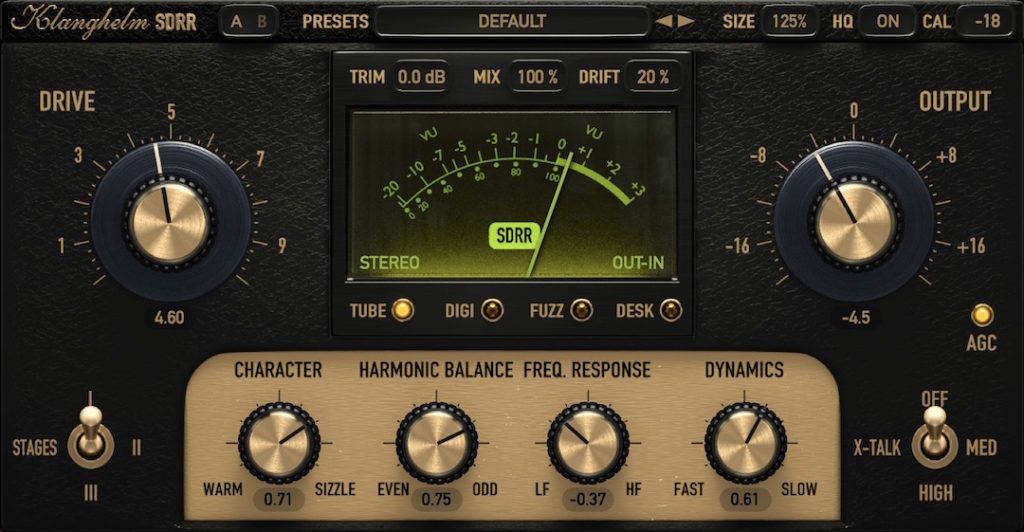 When I started researching this article I was really inspired by another tube-flavored Klanghelm plugin called the MJUC. It is an amazing—and amazingly affordable—plugin that emulates Vari-Mu compression.
When I started researching this article I was really inspired by another tube-flavored Klanghelm plugin called the MJUC. It is an amazing—and amazingly affordable—plugin that emulates Vari-Mu compression.
Vari-Mus are tube-based style compressor that are notoriously great for drums, groups or mastering. I love the MJUC, so when I saw their SDRR I had to give it a try too. It takes the great tube sound they have infused into their MJUC and isolates it, making for an excellent-sounding and easy-to-use plugin.
For such a cost effective plugin, you have so much control over tube types and tones. But in addition to providing a warming tube tone, it includes a few other flavors of saturation: Digi, Fuzz and Desk.
These saturators showcase the talented coding of Klanghelm and give you a whole menu of options for shaping the sound based on the needs of the material. SDRR can be many different things in one. It can be used as saturation, compression, EQ, stereo enhancement, or add some movement to your song with ‘drift control’ like that of a tape machine.
I suggest this plugin to anyone that feels like they want a bit of every everything in one solid plugin, and with that kind of price tag (~$28) it is a must have!!
Goliath from Tone Empire ($79)
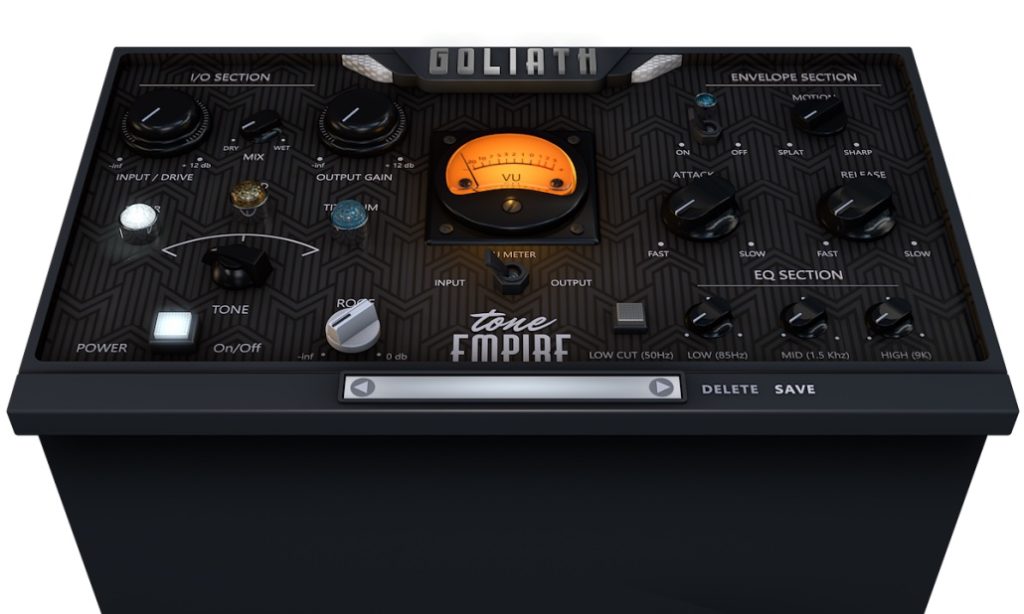 The Goliath is a new-comer to the saturation scene. When I first started using it, I realized it can get extreme really quick.
The Goliath is a new-comer to the saturation scene. When I first started using it, I realized it can get extreme really quick.
Unlike the main options above, it is not purely tube-focused and also has compression and EQ onboard and is meant to be something of a channel strip and saturator all-in-one.
I was hyped on how good it would sound on single instrument instances, especially synths and pads, where it can really imbue a nice sense of substance into them.
Initially, I was skeptical of using it on the mix bus or master bus, but after some time tweaking I found it was able to add a nice sense of sheen and glue on a mix bus or mastering chain.
This plugin has become a new staple for me over the past few weeks as I’ve realized the power and versatility it has. One cool feature here is the 3 modes of saturation: Silver (which represents solid state), Gold (tube), and Titanium (tape). I’ve found much more use with its gold (tube) setting for mix bus or mastering while the other two styles have been great for single instruments. But in this plugin, the gold setting is really the… well… the golden nugget!
Ironically, I’ve not found much use for the other features in this plugin. The EQ on board is a bit heavy handed for my tastes, and I would much rather just throw a trusted EQ into the chain before or after for more control, and same goes for compression. But at the price, if all you ever use is the saturation, it’s a great plugin and can give you a very nice sense of glow or grit depending how you want to use it.
Futzbox from McDSP ($129)
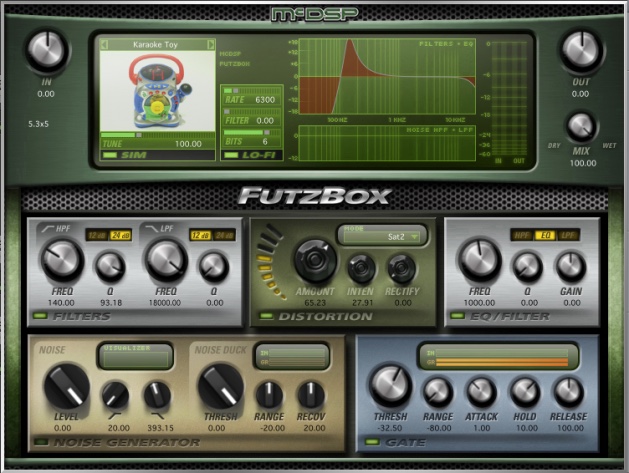 When it comes to the old-school companies in the plugin game, we can never forget McDSP. For 20 years, they have been hands down one of the best, and still are to this day.
When it comes to the old-school companies in the plugin game, we can never forget McDSP. For 20 years, they have been hands down one of the best, and still are to this day.
There are not many plugins I find myself using on nearly every mix or production I work on, but McDSP’s Futzbox is one of them. It’s a super cool and unique distortion and saturation unit that allows you to mimic the distortion sounds of everything from a child’s microphone toy to an old AM radio to a barrel, or even a bullhorn!
The types of saturation and distortion here are endless, really. Since it’s not really that tube-centric, I just can’t put it on the main list, but it has so many tube-based profiles on the simulation list (something called “synthetic impulse models or SIMS) such as an esoteric vacuum tube TV. For this reason, there’s no way we can leave this one off the list.
This swiss army knife of a plugin is a true driving force in my mixes whenever I want to add a distortion layer underneath a clean sound in a parallel setup. You can have so much great saturation control this way that I’d find it hard to do without. Highly recommended.
(For a more complex multiband approach to this concept, try iZotope’s Trash 2, a bit of a sleeper success for the brand.)
RC-20 Retro Color from XLN Audio ($79)
 Like the other entries in this honorable mentions section, the RC-20 does so much more than just emulate tube saturation, allowing you to stack up to 6 types of saturation, distortion or signal destruction in a row.
Like the other entries in this honorable mentions section, the RC-20 does so much more than just emulate tube saturation, allowing you to stack up to 6 types of saturation, distortion or signal destruction in a row.
When it comes to tube saturation however, you can be as subtle or heavy handed as needed within this plugin’s ”flux engine” and add some additional flavors of saturation to go along with it, bringing some warm analog sexiness to even the most sterile of signals.
The GUI here is very intuitive and nice to look at, too. Unlike the others that keep appearances very ”retro” in order to replicate the look of yesteryear’s tube gear, this one comes across looking very current and clean.
Just choose the types and amounts of modules and fx you want to stack inside the flux engine, and get to work. With this one, you can pull off nearly any old vintage color or tone with a very 21st century GUI and workflow.
Tubes: The past meets the future
Tubes, once a must-have element for signal amplification, are still a must have, but now for creating the kinds of memorable boutique tones that are almost impossible to get otherwise. Tubes may be a blast from the past, but with the way their implementation keeps evolving to meet the needs of the digital age, they seem destined to remain a part of music production’s future.
For more great insights into both mixing and mastering, try our full-length courses with SonicScoop editor Justin Colletti, Mixing Breakthroughs and Mastering Demystified.
Please note: When you buy products through links on this page, we may earn an affiliate commission.







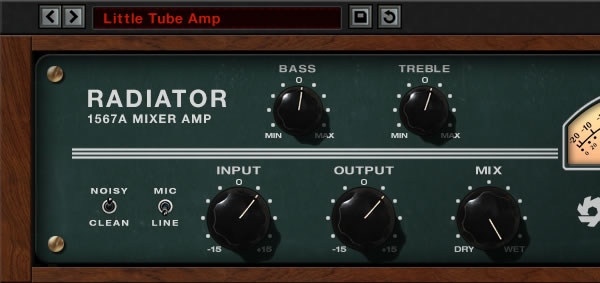
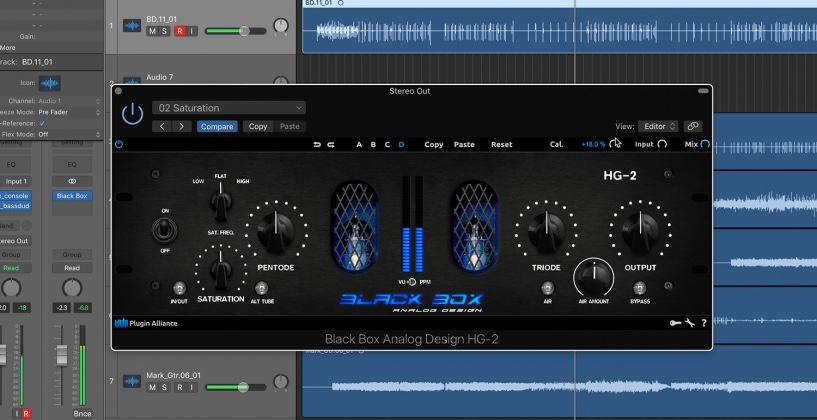

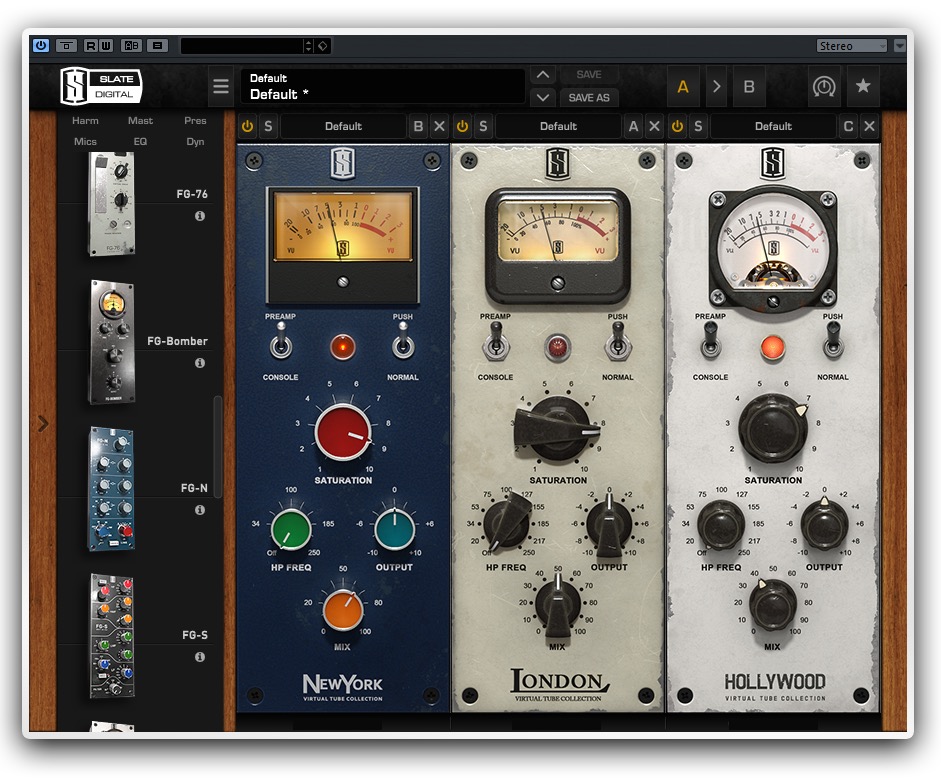
[…] The word “tube” causes many of us to instantly think of good ol’ classic tube guitar amps, “giving the guitar some glow”. But vacuum tubes, which were once a necessary component of most Read more… […]